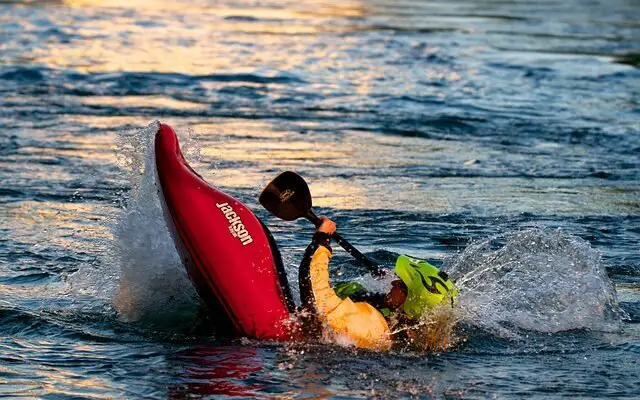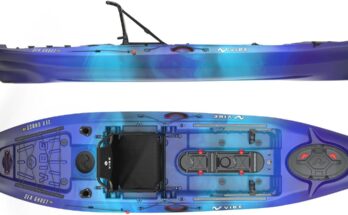What might be the motives a kayak would capsize? However, you’re wondering if can a Kayak sink?
Yes. An instructive poetry can sink because it is flooded with more water than its capacity or has suffered breakage damage. The worse the weather or the bigger the forces coming from the water the greater the chances of the kayak sinking.
Most importantly, thinking about the potential problem you can face with your boat, brings your to the water ready for any situation.
Sinking of a kayak is perhaps a far cry but don’t let that greedy liability become a reality. Don’t forget to carry along your safety devices and preferable accessories that assist in taking water out of a kayak and keep it afloat if it sinks.
Do you want to find out the reasons of your kayak sinking these steps? Then, keep on reading.

Can a Kayak Sink ?
Yes. The most common accident with Kayaks is maybe capsizing, but the chances of that to happen are pretty low. It will very rarely that time when you carry your kayak on your way. No other factor is also included.
Whether your Kayak will sink or not will rely on two main things- the type (plastic, composite, glass-fiber) and the loading. This last part of our investigation we will present few of them.
What Type of Kayaks Sink Easily?
Kayaks are grouped into two categories: corresponds among sit-ins and sit-on-tops. Whether you paddle in a sit-on or a sit-inside the kayak, it’s unlikely for them to sink in just by a simple force.
However, if you are in search of a kayak that is a close approximation of being unsinkable, the sit-on-top is the best candidate for you.
The sit-on-top kayaks are said to be unsinkable as long as they are inflated, but they can still take on water and sink when it is not masked.
This boat has a single molded hull Design and is, therefore, extremely hard to flip over. Two drains of the kayak are available, the scupper holes which help drain any water that gets into the hull.
One the other hand, sit-in kayak may sink more easily due to it not being scupper holes that drain water out of the kayak. Being on these boats without a bilge pump or other devices to suck up the water, they will at the end sink.
While they have much weaker side facing, at the same time, they have low center of gravity, which gives them more stability.
Will a Kayak Sink If It Flips Over?
Yes. The kayak maybe swamped if it’s flipped over and it tooks inside large volumes of water. A sit-in kayak design will face this issue since they are much to the water.
Also, it has an open hull. Water flooding and the kayak tips over when flipping it, which happens very often and ends up being the most common cause of capsizing the kayak.
It is safer for you to use a sitting-on-top kayak. It is rather more sturdy to turning over vertical position due to this.
Not a kayak that is made of one piece that is mostly closed, but a one-piece kayak seems to be more practical and they can to cater many different needs.
Lastly, along with scupper holes that permits the discharge of all water in case of any water getting inside the boat, a sit-on-top kayak is another feature of it.
Usually, the two kayak types are floating and they do not sink, except perhaps in uncommon situations.
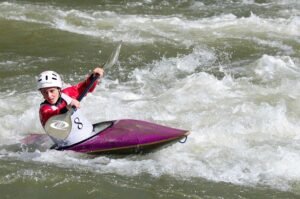
Why Would a Kayak Sink?
However, highly improbable but still it may happen that kayak can sink just as any other vessel. You may still wonder how do the kayak sunk.
Are finishes from kayaking or paddling adventures made safer, or are there factors that increase the risk of an accident ?
The answer is a resounding yes, and that is because of the next:
Taking a Huge Amount of Damage
Could you be in the water from your kayak with it being overloaded?
Unfortunately, yes.
Anything from making a wrong paddle touch the water to being completely immersed in it while kayaking may cause a grave failure.
Should the kayak flip over or you tip it into the water, then the water can sink your kayak.
What has been seen to happen this, but it is rare. A Kayak’s flip is due to a more prominent reason such as poor navigation skills or mistakes.
For any kayak to sink, another factor that might come in, is the usually severe climatic weather or a rough water. The weather demands only extreme skill to paddle in such circumstances, even for seasoned kayakers.
We recommend you don’t kayak during the bad weather as this could be dangerous and potentially damaging to your kayak.
Inexperience just as underwater is one of the simplest mistakes you can make. This is something that you will notice pretty much all the time, if you are new to the game.
Being a skilled kayaker occasionally presumes good posture, and you must apply the correct one.The boat can tip over and sink if you are not keen on maintaining balance.
A boat leak is also a problem to worry about if you have a sit-in kayak.
These boat types do not have scupper holes to drain water that gets into the boat complete the cracks on the hull.
Load On Your Kayak Is Too Heavy
The seat-in and the sit-on-top sheet-top is specific with a carrying capacity. Each manufacturer comes up with this particular magnitude with all of the models he builds.
Do not carry more than 70% even if you will have funny tabloids when you fill it with the ones on board. When increasing its capacity, it is necessary to take into account their number, the amount they will wear, and the weight of each one of them.
Otherwise, you will make the craft so top-heavy and unstable that it will be unable to maneuver. From our database of example sentences coming from different text sources,
we have selected the following sentence:
Pressing down on the throttle releases the emergency brake and moves the car forward.
The weight of boat and its contents will displace the water in the quantity that it carries. In other words, it results in excessive load at the boat that lies too low in the water.
Other wave actions apart from back waves can make a kayak to sink if it takes even the smallest water current, which is already moving because of too much weight.
Secure yourself kayaking by placing the permitted load not more than 70% to the limit of your kayak. It will also have massive impact on controlling propulsion and steerage.
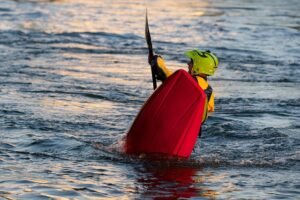
What to Do If A Kayak Is Full With Water?
The water could be inside your kayak for different reasons. This might be a hole or crack in your hull or water collection, when it capsizes. Apart from that, rain makes you at your paddling pool.
Whether you like it or not, your decision will take you to the next level or it will bring a disaster that will destroy you completely.
Consider the following to contract with water in your kayak:
Don’t Panic
Usually, kayakers feel turned back when the water get into their boat. As for me, I might encounter one of these reactions in a similar fashion, if that is my case and it was the first occurrence.
However, bear in mind that you must try your best to be calm as you have to make important decisions more carefully.
Panic often destroys the calmness of mind, it could lead to the urge to make actions which are undoubtedly wrong and may only end up in a catastrophe.
Rather, you should consider this as a mundane thing that happens to most people. Being composed is always the best choice.
Plug Up the Opening
If a person gets into this dilemma then the state of mind involved is what matters. If it is sunny skies, blowing winds, or flipping over, this water approach will be of no use. It will be a good fit if you are patching any holes on the bottoms.
Recognize where water enters in and seal it off. This should give you some respite and an opportunity to head for the shore to take a closer look at the circumstances.
Remove The Water
With that tool into account, the most suitable thing you can do if you are a sit-in kayak paddler is to drain the water or else plan how you will paddle the kayak back to show.
There, at the lower end of your boat is your bilge pump. With this manually operated pumping tool called bilge pump, you will eliminate any water from the boat.
Sit-on-top kayaks might be the best choice for you if you worry about keeping yourself dry since they drain themselves through scupper holes.
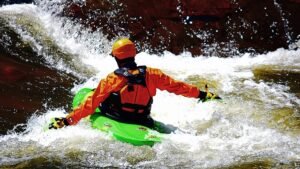
Wear a Life Vest
No matter what you say, having a life vest “strapped to yourself” and not “lying freely” next to you is the single most effective thing you could do to prevent the worst case scenario if the kayak is filling with water or starting to sink.
The fast swimmers probably will be fighting with the cold water while struggling to climb onto the kayak, and then finding their way to the land without life vest help.
And so, if we translate this thing to the circumstance wherein a sinking kayak forced us to leave it, you have to be grateful due to the fact that you wore a life vest.
Paddle at Your Skill Level
It is advisable not to paddle in weather and water if you haven’t explored it or that you aren’t sure or be okay with it. Catch up weather forecasts before heading out kayaking.
Dress for the Water Temperature
There’s this worn out saying in kayaking, “Don’t dress for the weather but for the water.” You will absolutely feel the truth in that. It is risky to go swimming even if you are in a warm air because your kayak can flip or the water can fill up your kayak.
If you’re cold, however, you need something like warm clothing, a wetsuit, or any kind of shield that will prevent the water from making you hypothermic. Just being on water for too long can get you into that; you don’t wish that.
Don’t Paddle Alone
No matter how capable you may be, yet don’t try to be a risk taker just to prove your adventure capability. Besides that, it is worth having a paddle buddy to keep you company in case when your kayak gets flooded or sinks.
Often, friends who go out with you in your kayak will motivate you to do it and will help in numerous ways, such as getting water out of your kayak, rolling it over to get back in your kayak and so forth.
The most unlucky is that you have to call a boat which will soon take you to the shore so that you don’t have to paddle all the way, but you do have someone to accompany you.
Bring Your Kayak Back to Shore
Consider all the above options and then chose the most appropriate action to employ, which could keep you alive. Take water from kayak out is time-consuming, and back up, where is bilge pump?
First, investigate the matter and seek the safety of the beach. While you could swim to that point in the worst-case scenario when none of the options are feasible, you should wait for a rescue by the emergency services since there are some dangerous currents.
What Can You Do To Prevent Your Kayak from Sinking
In order to keep your kayak from sinking, make sure to avoid overloading the hull, and for maneuverability as well as safety, avoid kayaking in bad weather.
It is worth to pay extra money for the safety equipment which could save your life in an emergency situation rather than to experience life-threatening conditions and become sorry for not doing more to protect yourself!
Consider using the following tips to prevent your kayak from sinking:
- When paddling, it is advisable that you wear life vest since you might capsize.
- Bear in mind the kayak’s capacity neither to carry over its weight-bearing limits – your weight and the gear you bring onboard are the factors to be considered here.
- Paddle according to your skill level, don’t get on the rough water if you are not enough powerful to handle the conditions over there.
- Have you ever experienced a good paddle where the weather was nice and was least expected till the rain hit you?
- Make sure bulkheads are in place so that water doesn’t leak into the boat through a crack or hole (e.g. in hull).
- Sit-on-top kayak plugs might in fact aren’t needed if you use a sit-on-top kayak. Leave some unplugged show them how they operate.
- Another aspect that could be emphasized in this case is flotation bladders that provide extra buoyancy both in the stern and bow of the sit-in kayak.
- Makes sure that your drain is plugged to the highest point and it should be secured at all times so that water cannot get into your kayak.
- Do not exit calmer waters on a particularly unsteady kayak. When the kayak is unstable don’t venture into deeper waters on a kayak that is overly unsteady.
Can a Kayak Sink? Conclusion
Despite the concerns and fears that it is easy and possible for the kayak to flip over, fill with water, or sink due to a variety of reasons and occurrences, it rarely or hardly happens. It is still not entirely safe and especially if you do not take some elementary measures, or gain some practice in relatively safer waters closer to the coast.
But if your kayak is filled with water or starts to sink, do not be anxious. Right your kayak again and use a bailer to throw the water out or use the bilge to scoop the water and paddle back to the shore.
While you indulge, do it in pairs, be these two humans, be safe and avoid the cardinal sin of kayaking especially when you are out in the middle of the ocean.

